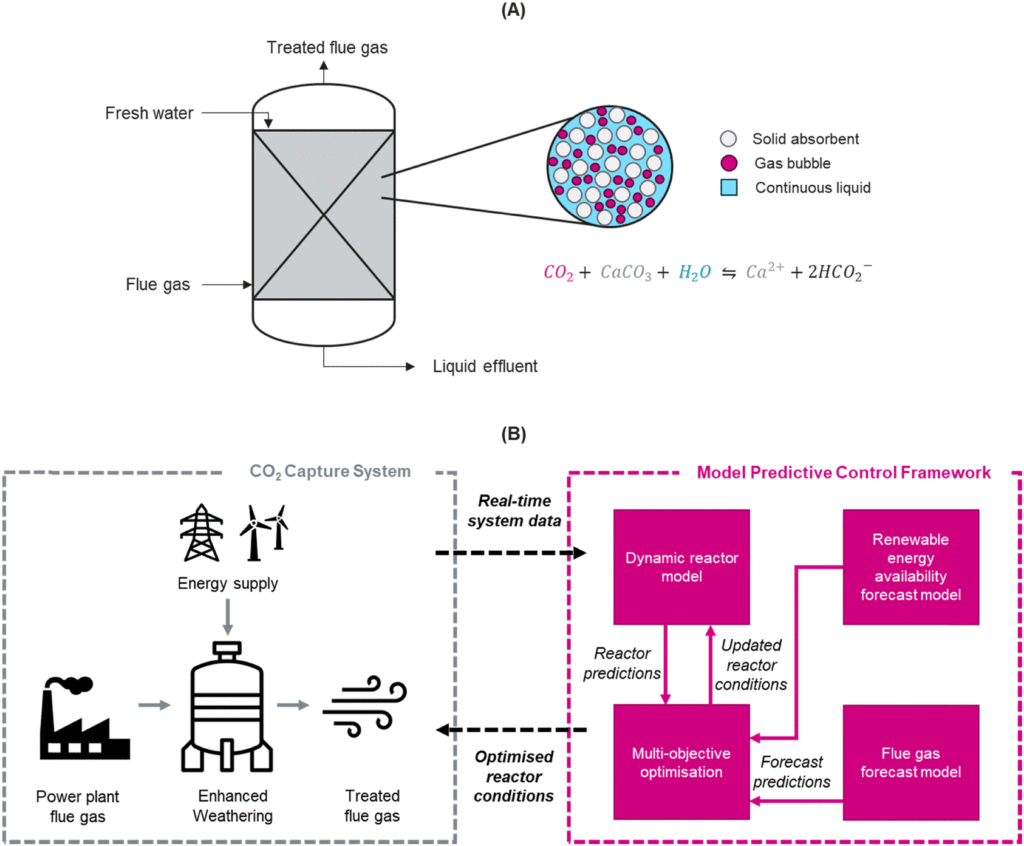Decreasing Energy Consumption for Carbon Capture by One Third Using Artificial Intelligence
3 min readIn a publication by the University of Surrey in Reaction Chemistry and Engineering, a team of researchers utilized artificial intelligence (AI) to improve the process of carbon capture in power plants, resulting in a decrease of energy usage by more than 33%.
Professor Jin Xuan, who is the chair of sustainable processes at the University of Surrey’s School of Chemistry and Chemical Engineering, led a study that focused on enhancing carbon capture systems.
The demonstration presents a simulated setup utilizing a genuine coal-fired power plant, implementing artificial intelligence to attain a 16.7% rise in carbon dioxide (CO2) sequestration, while concurrently decreasing non-energy usage from the UK’s national grid by 36.3%.
In an article published by the University of Surrey, Prof. Xuan highlighted the uniqueness of this method, stating that typically, carbon capture systems operate continuously at a fixed rate, regardless of external changes. However, our research demonstrated that training the system to make small adjustments can lead to significant energy conservation and increased carbon capture efficiency.
The process of carbon capture plays a crucial role in reducing the environmental consequences of CO2, the primary greenhouse gas emitted by the majority of power plants.
One common way to accomplish this is by utilizing enhanced weathering, which involves passing flue gas through water that contains limestone. This causes a reaction with calcium carbonate, resulting in the formation of harmless bicarbonate.
The process described in the study is highly dependent on energy, as it involves using power to pump water and CO2. To produce renewable energy, the CO2 capture plant in the study utilized a wind turbine, but when there was not enough wind power, it had to rely on energy from the grid.
The accomplishments of the research team involve implementing AI technology to enable the model system to anticipate variations in CO2 generation and the accessibility of renewable energy. This allowed for the system to adapt the pumping of water accordingly, resulting in an optimized utilization of energy over a period of time.
 Enhancing carbon capture techniques using the power of machine learning. Retrieved from Reaction Chemistry and Engineering.
Enhancing carbon capture techniques using the power of machine learning. Retrieved from Reaction Chemistry and Engineering.
According to Dr. Lei Xing, who is a chemistry and chemical engineering lecturer at the University of Surrey, their findings have significant implications. Dr. Xing emphasized that while their model was specifically tested on enhanced weathering, the principles can be applied to other processes as well. This model has the potential to assist anyone attempting to reduce energy usage while capturing and storing more CO2, regardless of the specific process they are using.
In hopes of supporting the United Nations’ Sustainable Development Goals, the researchers aim to utilize their discoveries to lessen the pressure on non-renewable energy resources and invest in pioneering technologies for carbon capture.
In January of this year, Microsoft utilized AI technology to develop a novel electrolyte for lithium batteries that can potentially decrease the amount of lithium needed by up to 70%. This discovery was reported by Daily AI in an article published on their website.
Further details on the research
The main goal of the research was to enhance the efficiency of carbon sequestration to minimize the reliance on depletable energy resources, all while preserving or enhancing the capture of CO2.
The system employed AI to adapt to minor fluctuations instead of operating continuously at a constant pace.
The method of operation is as follows:
Scientists have successfully developed machine learning models to accurately forecast the efficiency of CO2 capture and the energy consumption of the reactor. These models, specifically the LSTM and MLP, were utilized to predict two important factors in the process: the amount of CO2 in the gas from a coal plant and the availability of wind energy. These predictions are crucial for planning the capture process. To ensure the accuracy of the models, the team conducted rigorous testing using statistical methods and a technique called conformal prediction to determine the level of confidence in the predictions. With the data from the AI models, a sophisticated algorithm was employed to optimize the capture process by finding the optimal balance between CO2 capture and energy usage. The results of the study showed that, on average, the reactor was able to capture 16.7% more CO2 and consume 36.3% less non-renewable energy over the course of one month.
The utility of AI in technology for reducing energy consumption is exemplified by this.
Efficient resource usage can be achieved by implementing lightweight AI systems into energy-consuming processes and appliances, allowing them to optimize their functionality.

